Enhancing Access for Students with Dyslexia
Amanda Henderson
Introduction
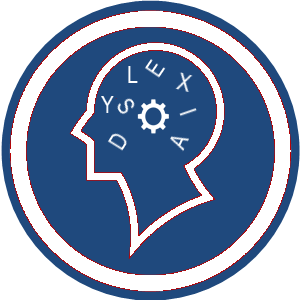 In the education system, ensuring that all students have equal opportunities to learn is essential. According to Tarjiah et al, “Dyslexia is a neurodevelopmental disorder that may lead to difficulties in reading and other language-related cognitive processes” (2023). These difficulties are typically a result of a deficit in the phonological component of language (Dyslexia Canada, n.d.). The International Dyslexia Association states that “10-20% of the population has a language-based learning disability” (n.d.). It affects males and females equally, as well, as different ethnic and socio backgrounds. Dyslexia is a hereditary disability, and it is caused by genetics. There are typically signs and indicators of dyslexia in children that appear as early as preschool age (Dyslexia Canada, n.d.). However, all children learn at their own pace but when a child is struggling with reading and writing, it could be dyslexia. Some indicators to look for are language, reading (decoding), writing, spelling, rhyming, and speaking challenges. Students with dyslexia, do not struggle in the same way. Some students will struggle with sounding out words, while others have comprehension struggles. As students age, it can look different and change over time (Dyslexia Canada, n.d.).
In the education system, ensuring that all students have equal opportunities to learn is essential. According to Tarjiah et al, “Dyslexia is a neurodevelopmental disorder that may lead to difficulties in reading and other language-related cognitive processes” (2023). These difficulties are typically a result of a deficit in the phonological component of language (Dyslexia Canada, n.d.). The International Dyslexia Association states that “10-20% of the population has a language-based learning disability” (n.d.). It affects males and females equally, as well, as different ethnic and socio backgrounds. Dyslexia is a hereditary disability, and it is caused by genetics. There are typically signs and indicators of dyslexia in children that appear as early as preschool age (Dyslexia Canada, n.d.). However, all children learn at their own pace but when a child is struggling with reading and writing, it could be dyslexia. Some indicators to look for are language, reading (decoding), writing, spelling, rhyming, and speaking challenges. Students with dyslexia, do not struggle in the same way. Some students will struggle with sounding out words, while others have comprehension struggles. As students age, it can look different and change over time (Dyslexia Canada, n.d.).
In K-12 education, students with dyslexia often face challenges that hinder their academic performance and overall learning experience. This chapter explores the nature of these challenges and suggests solutions to enhance accessibility and support for students with dyslexia. However, students with dyslexia often face significant barriers that prevent them from accessing the same learning opportunities as their peers.
Challenges Faced by Students with Dyslexia
Students with dyslexia encounter a range of challenges that can impact their academic performance and overall learning experience. These challenges are often multifaceted, affecting various aspects of reading, comprehension, and writing. Some major challenges faced by students with dyslexia include reading, writing, and information overload.
Reading
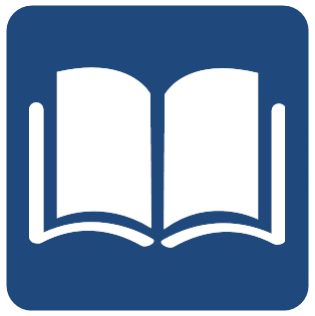 Students with dyslexia often face challenges with decoding when learning to read. This difficulty arises from the way we acquire reading skills. Learning to read is a complex process. When learning to read the brain is learning to map between print and sound. The mappings are between phonemes which are the smallest until of speech, and graphemes, letters, and letter groups called diagraphs (Snowling et al., 2020). However, in English, there are many inconsistencies in the mappings, making it challenging to read. As children learn the alphabetic code, they can translate print into sounds and from that access the meaning of familiar words (Snowling et al., 2020). Over time, with experience, relying on decoding decreases, and word recognition becomes increasingly automatized as they gain automaticity. This allows children to go from print to meaning rapidly and effortlessly. For students with dyslexia, they are slower to learn to decode and gain fluency. According to Snowling et al. (2020) “[i]t is well established that in cognitive terms, dyslexia is caused by problems at the level of phonological representation.” When students are struggling to decode, and read, it has other effects. Students with dyslexia will often have poor comprehension skills due to labored reading. Students typically struggle with reading the text, processing it, and understanding the meaning of the text they are reading. Struggling with reading can lead to frustration, reduced self-esteem, and more likely to avoid reading tasks.
Students with dyslexia often face challenges with decoding when learning to read. This difficulty arises from the way we acquire reading skills. Learning to read is a complex process. When learning to read the brain is learning to map between print and sound. The mappings are between phonemes which are the smallest until of speech, and graphemes, letters, and letter groups called diagraphs (Snowling et al., 2020). However, in English, there are many inconsistencies in the mappings, making it challenging to read. As children learn the alphabetic code, they can translate print into sounds and from that access the meaning of familiar words (Snowling et al., 2020). Over time, with experience, relying on decoding decreases, and word recognition becomes increasingly automatized as they gain automaticity. This allows children to go from print to meaning rapidly and effortlessly. For students with dyslexia, they are slower to learn to decode and gain fluency. According to Snowling et al. (2020) “[i]t is well established that in cognitive terms, dyslexia is caused by problems at the level of phonological representation.” When students are struggling to decode, and read, it has other effects. Students with dyslexia will often have poor comprehension skills due to labored reading. Students typically struggle with reading the text, processing it, and understanding the meaning of the text they are reading. Struggling with reading can lead to frustration, reduced self-esteem, and more likely to avoid reading tasks.
Writing
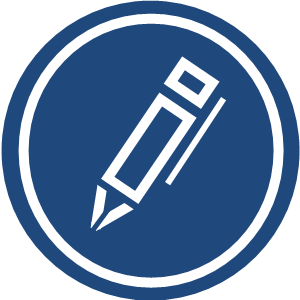 Students with dyslexia often struggle with writing. Writing is linked to reading as they use the same processes in the brain. According to Hebert et al., “reading is theorized to be a central component of writing in some cognitive models of writing development” (2018). Writing difficulties can be attributed to their reading difficulties. Writing difficulties can present in many ways such as poor spelling, poor legibility, lack of diverse vocabulary, poor idea development, and/or lack of organization. Writing difficulties occur for two main reasons. The first reason would be writing relies on underlying processes. Writing relies on the encoding process which is the ability to break down spoken words and write them down (Hebert et al., 2018). Secondly, reading is a subskill of writing. Writers often need to read materials before writing and need to read/reread their writing to find spelling errors, grammar errors, and disorganization (Hebert et al., 2018). Additionally, if students have poor handwriting skills, it can make it more challenging for them to read their work. Writing difficulties can make assignments for students more challenging, time-consuming, and daunting (Hebert et al., 2018).
Students with dyslexia often struggle with writing. Writing is linked to reading as they use the same processes in the brain. According to Hebert et al., “reading is theorized to be a central component of writing in some cognitive models of writing development” (2018). Writing difficulties can be attributed to their reading difficulties. Writing difficulties can present in many ways such as poor spelling, poor legibility, lack of diverse vocabulary, poor idea development, and/or lack of organization. Writing difficulties occur for two main reasons. The first reason would be writing relies on underlying processes. Writing relies on the encoding process which is the ability to break down spoken words and write them down (Hebert et al., 2018). Secondly, reading is a subskill of writing. Writers often need to read materials before writing and need to read/reread their writing to find spelling errors, grammar errors, and disorganization (Hebert et al., 2018). Additionally, if students have poor handwriting skills, it can make it more challenging for them to read their work. Writing difficulties can make assignments for students more challenging, time-consuming, and daunting (Hebert et al., 2018).
Information Overload
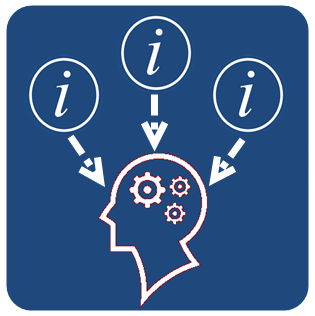 Students with dyslexia can experience information overload. When the material is too much and all at one time, it can become stressful for students (Butcher, 2021). There are three main reasons for information overload. The first reason students might experience information overload is that students tend to process incoming information differently compared to other students (Butcher, 2021). Dyslexics may process information more slowly, and often recognize/identify information in pictures or images instead of words (Butcher, 2021). Secondly, students may struggle with memory and information retention. Therefore, individuals may struggle with recalling and remembering information. Finally, students may have difficulty with processing and receiving large portions of information especially if presented in a format they struggle with (Butcher, 2021). An example of this would be, a large amount of text to read in a limited period or crowded textbooks that lack scaffolding. Scaffolding refers to the process where a teacher will offer support for students learning new concepts or skills. An example of this would be “I do, We do, You do” (GCU, 2019).
Students with dyslexia can experience information overload. When the material is too much and all at one time, it can become stressful for students (Butcher, 2021). There are three main reasons for information overload. The first reason students might experience information overload is that students tend to process incoming information differently compared to other students (Butcher, 2021). Dyslexics may process information more slowly, and often recognize/identify information in pictures or images instead of words (Butcher, 2021). Secondly, students may struggle with memory and information retention. Therefore, individuals may struggle with recalling and remembering information. Finally, students may have difficulty with processing and receiving large portions of information especially if presented in a format they struggle with (Butcher, 2021). An example of this would be, a large amount of text to read in a limited period or crowded textbooks that lack scaffolding. Scaffolding refers to the process where a teacher will offer support for students learning new concepts or skills. An example of this would be “I do, We do, You do” (GCU, 2019).
Proposed Solutions
As educators, it is crucial to provide students with dyslexia the specific support they need for their academic success and overall well-being. Dyslexia presents unique challenges that require target strategies. The following solutions aim to create a more inclusive and supportive learning environment for students with dyslexia, enabling them to overcome challenges and barriers. These solutions encompass a range of approaches from implementing a Universal Design of Learning to Assistive Technology to create an inclusive classroom. Here are some solutions to help students with dyslexia in the learning environment.
Instructional Design
Universal Design for Learning (UDL) Principles
Universal Design for Learning (UDL) is a “scientifically valid framework for guiding educational practice that:
- provides flexibility in the ways: information is presented, students are engaged, and students respond or demonstrate knowledge and skills.
- reduces barriers in instruction, provides appropriate accommodations, supports, and challenges, and maintains high achievement expectations for all students, including students with disabilities and students who are limited English proficient” (Research Guides at Mt San Antonio College, n.d.).
Figure 1
Domains of UDL (CAST, 2018)
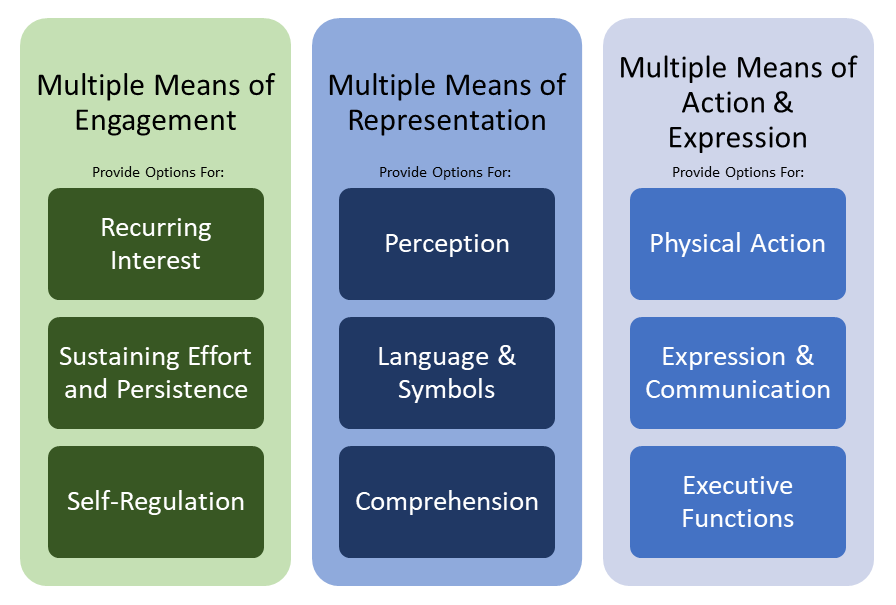
Multiple Means of Representation
When giving content, provide it in different formats. Different examples of formats would be text, audio, video, and interactive graphics to meet different learning preferences. These are called multiple means of representation or multimedia learning environments (Knoop-van Campen et al., 2022). Multimedia environments have become an important part of learning (Knoop-van Campen et. al, 2022). Knoop van Campen et al. (2022) state “These principles focus on minimizing the burden on the working memory so that working memory capacity can be used to process the information stored in long-term memory. Off-loading working memory capacity to enhance learning.” It is recommended to use graphic organizers, charts, and visuals to support text-based information. This allows for the modality principle. To the best, modality, you should pair audio with pictures instead of text.
Multiple Means of Action and Expression
Multiple means of action and expression means that student should be allowed to demonstrate their understanding in various diverse ways. According to MT SAC library, “learners differ in the ways that they can navigate a learning environment and express what they know” (2024). This can be done through oral presentations, visual projects, or interactive activities. When doing this you should incorporate different technologies that support students to use different assistive technology. Examples of this would be voice-to-text or text-to-speech.
Readable Text and Layout
Clear Fonts and Layouts
 When typing and using fonts ensure they are dyslexia-friendly fonts (for example, OpenDyslexic, Arial, or Verdana) and ensure there is adequate line spacing and font size. A study conducted by Rello and Baeza-Yates (2017), found that larger found size improves readability, larger character spacing, no greyscale, and standard character spacing and 44 characters per line was best for readers with dyslexia (2017).
When typing and using fonts ensure they are dyslexia-friendly fonts (for example, OpenDyslexic, Arial, or Verdana) and ensure there is adequate line spacing and font size. A study conducted by Rello and Baeza-Yates (2017), found that larger found size improves readability, larger character spacing, no greyscale, and standard character spacing and 44 characters per line was best for readers with dyslexia (2017).
Simplified Layouts
When giving out instructional materials, it needs to be clear and concise. For example, the instructions need clear headings, bullet points, and white spaces to enhance readability. Clear headings help to organize information and guide the reader through the material. According to Lorch, “headings and subheadings structure information in a way that makes it easier to process and recall” (1989). Bullet points break down complex information into manageable chunks, which can help comprehension and retention. As well you could also use chunking which is breaking down information into smaller, more manageable sections with clear headings and subheadings. As noted by Hartley, “bullet points can make the text more digestible and accessible by highlighting key points and separating information into distinct units” (2014). These design elements help make the content more accessible. When structuring information, you should include summaries and key points at the beginning or end of sections to reinforce understanding and retention. Students with dyslexia often struggle with memory and retention. Adding reinforcement, allows the students to hear the information once more, helping them to more likely retain the information.
Interactive and Engaging Content
When presenting content for students, the content should be interactive and engaging for students. First off, you can present content, in multiple media. Examples of this would be videos, animations, and interactive simulations to present complex information in an accessible way. Another way to make content interactive and engaging would be to use gamified learning. Incorporating game-based learning is a way to make content interactive, less intimidating and overwhelming.
Digital Resource Solutions
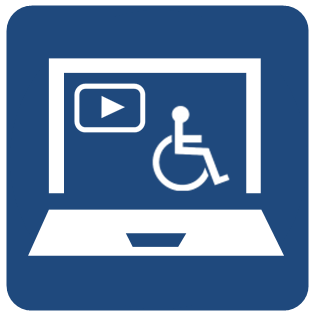 When using digital tools in education, often accessibility challenges can affect the learning experience of students with dyslexia. Although technology and educational resources have advanced, many digital platforms and materials still lack accessibility, creating barriers and challenges for students. This section will discuss different solutions to alleviate the barriers. As stated above, there are many different challenges for students with dyslexia. Often, they struggle with reading and writing, and content overload. However, there are solutions that educators in the K-12 system can use to relieve some of the stressors for students with dyslexia. The first one would be to use different assistive technologies. According to Dawson et al. (2018):
When using digital tools in education, often accessibility challenges can affect the learning experience of students with dyslexia. Although technology and educational resources have advanced, many digital platforms and materials still lack accessibility, creating barriers and challenges for students. This section will discuss different solutions to alleviate the barriers. As stated above, there are many different challenges for students with dyslexia. Often, they struggle with reading and writing, and content overload. However, there are solutions that educators in the K-12 system can use to relieve some of the stressors for students with dyslexia. The first one would be to use different assistive technologies. According to Dawson et al. (2018):
The term assistive technology (AT) refers to the services and devices that enable people with disabilities to accomplish daily living tasks; assist them in communication, education, work, or recreation activities; and ultimately, help them achieve greater independence and enhance their quality of life.
For example, text-to-speech tools. When you integrate text-to-speech software, it can help students with dyslexia listen to written content and “enabling learners with challenges accessing printed text to access to the content. (Dawson et al., 2018). This will help the student comprehend the text and reduce reading fatigue. Dawson et al., highlight how AT, “can be beneficial for students with dyslexia who exhibit weak decoding skills, low levels of fluency, and strong listening comprehension skills” (2018). Students with dyslexia often struggle with writing and spelling. A solution for this would be speech recognition software. It allows students to verbally response to questions and the software will write their responses for them. This helps students overcome their writing difficulties. A piece of assistive technology that combines both text-to-speech and speech-to-text would be a Chrome extension called Google Read and Write (TextHelp, 2024). Google Read and Write provides a toolbar that allows users to select from the different options such as text-to-speech, speech to text-and-word prediction. Other options include Speak It! (2023), NaturalReader (Naturalsoft, n.d.), Bookshare (Beneficent Technology, 2024), and Audible (2024) for accessing information, and Mercury Reader (Softonic, n.d.), Beeline Reader (2017), and Voice Dream Reader (2024), for the display of information. Dawson et al. (2018) list AT tools for writing and spelling, including word processors, voice typing, CO:Writer Universal (Don Johnston Incorporated, 2016), Write:Outloud, and Siri (Apple Inc., 2024).
Implementation and Best Practices
Training and Awareness
 As educators, there are certain strategies that we can implement for ourselves, our students, and their families. Implementing training for staff such as professional development. By providing ongoing training for educators on the best practices for teaching students with dyslexia, including assistive technology and UDL principles. An example of this would be a book club discussing the book UDL NOW! This will help educate staff on understanding dyslexia, which will help to create an inclusive classroom/school environment that is supportive. As well, schools can conduct awareness campaigns to educate the school community about dyslexia and the importance of accessibility in education. Parents should be involved in campaigns to help them understand and support that is provided to their children.
As educators, there are certain strategies that we can implement for ourselves, our students, and their families. Implementing training for staff such as professional development. By providing ongoing training for educators on the best practices for teaching students with dyslexia, including assistive technology and UDL principles. An example of this would be a book club discussing the book UDL NOW! This will help educate staff on understanding dyslexia, which will help to create an inclusive classroom/school environment that is supportive. As well, schools can conduct awareness campaigns to educate the school community about dyslexia and the importance of accessibility in education. Parents should be involved in campaigns to help them understand and support that is provided to their children.
Policy and Standard
 Schools need to develop policies that are school-wide, to mandate the creation of accessible learning materials and environments for students. They need to ensure these policies are aligned with the national and international accessibility standards. When using digital content, ensure it adheres to the Web Content Accessibility Guidelines (WCAG) 2.1. WCAG provides a set of criteria for making content accessible to individuals with disabilities. This will allow them to comprehend content better. As well, it needs to comply with the Accessible Canada Act, which mandates the identification, removal, and prevention of barriers in all areas including information and communication technologies. This allows for means ensuring that digital educational resources are designed to be accessible, allowing them to access and engage with content without unnecessary difficulties. Ensuring digital content adheres to these standards is crucial for supporting students. They provide a framework for creating accessible educational materials that enhance their education and learning.
Schools need to develop policies that are school-wide, to mandate the creation of accessible learning materials and environments for students. They need to ensure these policies are aligned with the national and international accessibility standards. When using digital content, ensure it adheres to the Web Content Accessibility Guidelines (WCAG) 2.1. WCAG provides a set of criteria for making content accessible to individuals with disabilities. This will allow them to comprehend content better. As well, it needs to comply with the Accessible Canada Act, which mandates the identification, removal, and prevention of barriers in all areas including information and communication technologies. This allows for means ensuring that digital educational resources are designed to be accessible, allowing them to access and engage with content without unnecessary difficulties. Ensuring digital content adheres to these standards is crucial for supporting students. They provide a framework for creating accessible educational materials that enhance their education and learning.
Conclusion
Addressing the accessibility challenges faced by students with dyslexia in K-12 education is crucial for their academic success and overall well-being. By implementing comprehensive instructional design principles and digital resource solutions, educators can create a more inclusive and supportive learning environment. This not only benefits students with dyslexia but also enhances the educational experience for all learners, fostering a more equitable and effective educational system.
References
Apple Inc. (2024). Siri. https://www.apple.com/ca/siri/
Audible (2024). https://www.audible.ca/
BeeLine Reader (2017). https://www.beelinereader.com/
Beneficent Technology (2024). Bookshare: Learn Without Limits. https://www.bookshare.org/
Butcher, H. (2021, September 7). Information overload. Dyslexia the Gift Blog. https://blog.dyslexia.com/information-overload/
Canadian Human Rights Commission (2023, September 19). Overview of the Accessible Canada Act. https://www.accessibilitychrc.ca/en/overview-accessible-canada-act
Dawson, K., Antonenko, P., Lane, H., & Zhu, J. (2019). Assistive Technologies to Support Students With Dyslexia. TEACHING Exceptional Children, 51(3), 226-239. https://doi.org/10.1177/0040059918794027
Don Johnston Incorporated (2016). Co:Writer. https://cowriter.com/
Dyslexia Canada. (n.d.). Dyslexia Basics. https://dyslexiacanada.org/en/dyslexia-basics
Grand Canyon University (2019). What is scaffolding in education and how is it applied. https://www.gcu.edu/blog/teaching-school-administration/what-scaffolding-in-education-how-applied
Hartley, J. (2014). Designing instructional text. Routledge.
Hebert, M., Kearns, D. M., Hayes, J. B., Bazis, P., & Cooper, S. (2018). Why Children With Dyslexia Struggle With Writing and How to Help Them. Language, speech, and hearing services in schools, 49(4), 843–863. https://doi.org/10.1044/2018_LSHSS-DYSLC-18-0024
Knoop‐van Campen, C. A. N., Segers, E., & Verhoeven, L. (2018). The modality and redundancy effects in multimedia learning in children with dyslexia. Dyslexia (Chichester, England), 24(2), 140–155. https://doi.org/10.1002/dys.1585
Lorch, R. F. (1989). Text-signaling devices and their effects on reading and memory processes. Educational Psychology Review, 1(3), 209-234.
Mt. San Antonio College Library (2024, February 6). Universal Design for Learning (UDL). https://mtsac.libguides.com/udl/overview
Naturalsoft (n.d.). NaturalReader. https://www.naturalreaders.com/
Rello, L., & Baeza-Yates, R. (2017). How to present more readable text for people with dyslexia. Universal Access in the Information Society, 16(1), 29–49. https://doi.org/10.1007/s10209-015-0438-8
Snowling, M. J., Hulme, C., & Nation, K. (2020). Defining and understanding dyslexia: past, present and future. Oxford review of education, 46(4), 501–513. https://doi.org/10.1080/03054985.2020.1765756
Softonic (n.d.). Mercury Reader. [Web application]. https://mercury-reader.en.softonic.com/
Speak It! (2023, November 24). [Web application] https://chromewebstore.google.com/detail/speak-it/fginjphhpgkicbhibgafbpfjeahmjdfc?hl=en
Tarjiah, I., Supena, A., Pujiastuti, S. I., & Mulyawati, Y. (2023, May 26). Increasing the reading ability of a student with dyslexia in elementary school: An explanatory case study by using family support, remedial teaching, and multisensory method. Frontiers. https://www.frontiersin.org/articles/10.3389/feduc.2023.1022580/full
Texthelp (2024). Read&Write for Google Chrome. https://www.texthelp.com/products/read-and-write-education/for-google-chrome/
U.S. Department of Education (2023). Higher Education Opportunity Act – 2008. https://www2.ed.gov/policy/highered/leg/hea08/index.html
Voice Dream (2024). https://www.voicedream.com/
